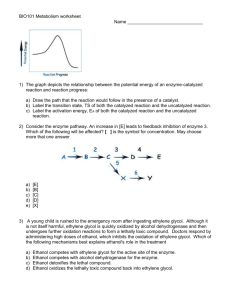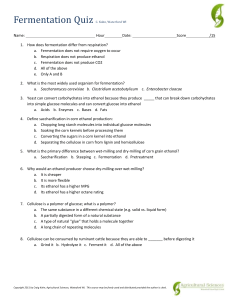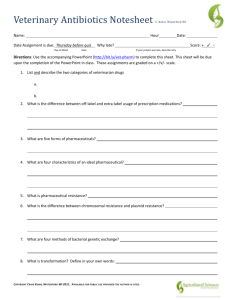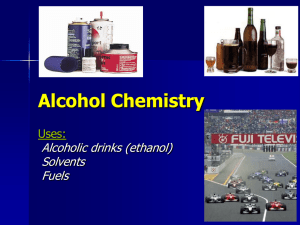Spring 2011 Biotechnology & Biofuels Final Name (print large and
advertisement
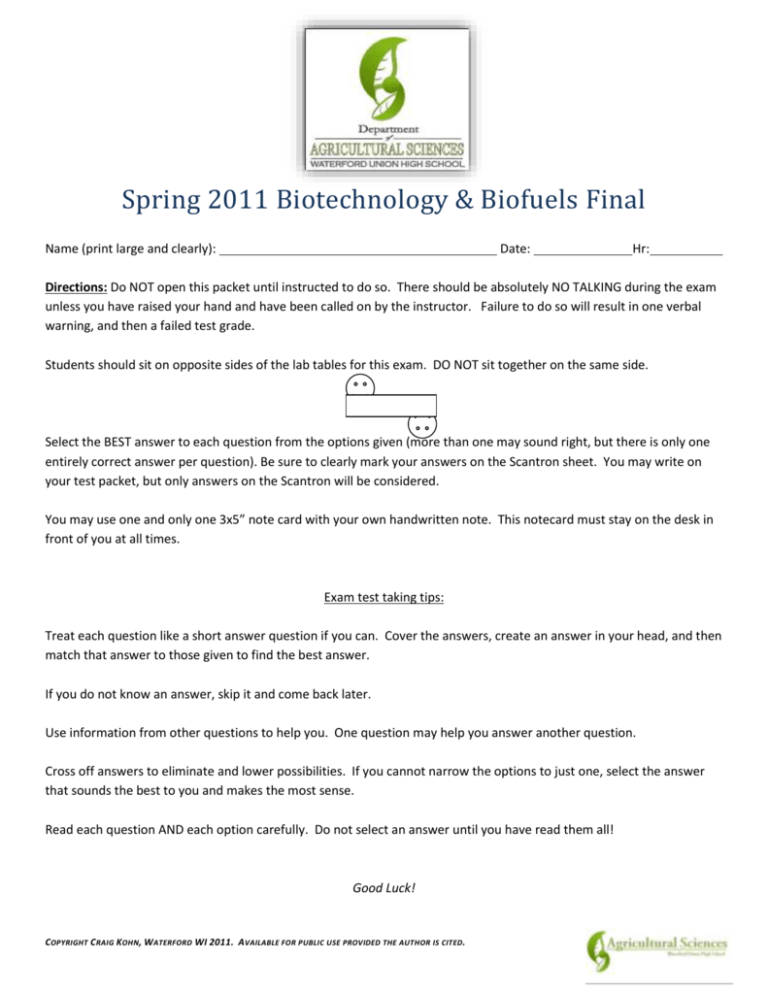
Spring 2011 Biotechnology & Biofuels Final Name (print large and clearly): Date: Hr: Directions: Do NOT open this packet until instructed to do so. There should be absolutely NO TALKING during the exam unless you have raised your hand and have been called on by the instructor. Failure to do so will result in one verbal warning, and then a failed test grade. Students should sit on opposite sides of the lab tables for this exam. DO NOT sit together on the same side. Select the BEST answer to each question from the options given (more than one may sound right, but there is only one entirely correct answer per question). Be sure to clearly mark your answers on the Scantron sheet. You may write on your test packet, but only answers on the Scantron will be considered. You may use one and only one 3x5” note card with your own handwritten note. This notecard must stay on the desk in front of you at all times. Exam test taking tips: Treat each question like a short answer question if you can. Cover the answers, create an answer in your head, and then match that answer to those given to find the best answer. If you do not know an answer, skip it and come back later. Use information from other questions to help you. One question may help you answer another question. Cross off answers to eliminate and lower possibilities. If you cannot narrow the options to just one, select the answer that sounds the best to you and makes the most sense. Read each question AND each option carefully. Do not select an answer until you have read them all! Good Luck! C OPYRIGHT C RAIG K OHN, W ATERFORD WI 2011. A VAILABLE FOR PUBLIC USE PROVIDED THE AUTHOR IS CITED . 1. Why might a woman be more affected than a man by the same level of alcohol consumption? a. Women typically have a higher percentage of body fat, resulting in less alcohol removed from the bloodstream b. Men typically have a lower body weight, meaning it would affect them less c. Men are more likely to consume carbonated versions of alcoholic drinks, which are absorbed less rapidly. d. All of the above 2. How is alcohol processed by the liver? a. Alcohol, when it enters the liver, is broken down by ALDH into acetaldehyde. This is broken down into acetate by ADH b. Alcohol, when it enters the liver, is broken down by ADH into acetaldehyde. This is broken down into acetate by ALDH c. Alcohol is converted into one of two products – if the body had the gene for ADH, it is broken down into acetate; if the body has the gene for ALDH, it is broken down into acetaldehyde 3. Why is judgment impaired by alcohol consumption? a. Alcohol speeds up the nervous system, preventing it from effectively processing information b. Alcohol impairs the ability of neurons to fire, preventing the brain from working at its normal ability c. Alcohol only impairs your judgment if you have had to much d. Alcohol does not impair the judgment of everyone – just those with the gene for ADH 4. Why would a person who has been consuming alcohol have irregular emotional swings? a. Alcohol impairs a person’s judgment by depressing the function of the frontal cortex b. Alcohol causes the fluid in the semicircular canals to change its consistency c. The acetaldehyde causes inflammation in the body, including the emotional centers of the brain d. Alcohol depresses the ability of the amygdala to regulate emotion 5. What causes flushing, or redness in the face, when consuming alcohol? a. Inflammation from acetaldehyde b. Inflammation from acetate c. Inflammation from alcohol d. A depressed central nervous system 6. Why would a person who has consumed alcohol feel the need to urinate more frequently? a. Alcohol is a diuretic, causing the body’s cells to shed water b. Alcohol interferes with the kidney’s ability to return water to the bloodstream c. Alcohol interferes with the bladders ability to determine how full it is d. All of the above 7. Why would a person feel more fatigued after consuming alcohol? a. Alcohol depresses the central nervous system b. Alcohol causes the fluid in the semicircular canals to change its consistency c. Alcohol impairs the release of glutamine, which allows the body to fall asleep d. Alcohol impairs the release of glutamine, a natural stimulant C OPYRIGHT C RAIG K OHN, W ATERFORD WI 2011. A VAILABLE FOR PUBLIC USE PROVIDED THE AUTHOR IS CITED . 8. What is the most effective cure to a hangover? a. Coffee b. Juice c. Time d. More alcohol 9. EISA is… a. The Energy Independence a Security Act, legislation that requires the US to use at least 15 billion gallons of corn ethanol per year b. The Energy Independence a Security Act, legislation that requires the US to cap corn ethanol use at 15 billion gallons per year c. The Energy Increment Surcharge Act, legislation that requires higher taxes on renewable energy than fossil fuels d. The Energy Increment Surcharge Act, legislation that requires lower taxes on renewable energy than fossil fuels 10. The biggest hurdle in adopting cellulosic ethanol on a larger scale is… a. Creating enough supply of cellulose b. Harvesting the cellulose c. Pretreatment and Hydrolysis d. Designing cars that can use cellulosic ethanol 11. Pretreatment is… a. Fermenting the cellulose into ethanol b. Cutting the cellulose chain into individual glucose units c. Exposing the cellulose by opening the cell walls d. Identifying microbes that can break down cellulose 12. Hydrolysis is… a. Fermenting the cellulose into ethanol b. Cutting the cellulose chain into individual glucose units c. Exposing the cellulose by opening the cell walls d. Identifying microbes that can break down cellulose 13. Bioprospecting is… a. Fermenting the cellulose into ethanol b. Cutting the cellulose chain into individual glucose units c. Exposing the cellulose by opening the cell walls d. Identifying microbes that can break down cellulose 14. Why was an ant colony chosen as a potential area for research and biosprospecting for biofuels? a. The ants eat leaves; to do so, they must produce enzymes to break down cellulose b. The ants eat fungus; to do so, they must produce enzymes to break down cellulose c. The ants feed broken down leaves to fungus and use microbes to break down the leaves so the fungi can eat them d. The ants produce antibiotics to protect the leaves from fungus C OPYRIGHT C RAIG K OHN, W ATERFORD WI 2011. A VAILABLE FOR PUBLIC USE PROVIDED THE AUTHOR IS CITED . 15. An enzyme is… a. A protein that speeds up or slows down a chemical reaction. b. A sugar that speeds up or slows down a chemical reaction. c. A portion of a long chain of molecules d. A molecule that can copy itself to make more molecules 16. In regards to enzymes, a substrate is… a. The molecule broken down by an enzyme b. The molecule that breaks down an enzyme c. A substance that regulates an enzyme’s activity d. A substance that promotes an enzyme’s activity 17. All enzymes have an active site, which is… a. Where the substrate binds to the enzyme protein b. Where the substrate is broken down by the enzyme c. The regulatory site of the enzyme d. The enzyme’s weakest point 18. “Induced fit” refers to… a. The enzyme’s transition into a new kind of enzyme after binding a substrate b. The change created in a substrate after an enzyme binds to it c. The ability to use any enzyme for any substrate d. The ability of an enzyme to bind to and fit around a substrate to break it down 19. A biochemical pathway is… a. The creation of different components of a substrate b. The process in which an enzyme changes into new molecules to break down different substrates c. The use of multiple enzymes in a predictable pattern to break down the substrate in a series of steps d. A series of chemical steps in which a substrate is created 20. What does it mean to “plate” a microbe during bioprospecting? a. To grow the microbes separately from all other microbes b. To test the microbe’s cellulasic activity c. To grow the microbe on cellulosic petri dish plates d. To test the microbes on feedstocks 21. Which describes the Isolation step during bioprospecting? a. To grow the microbes separately from all other microbes b. To test the microbe’s cellulasic activity c. To grow the microbe on cellulosic petri dish plates d. To test the microbes on feedstocks 22. Which describes the Screening Step during bioprospecting? a. To grow the microbes separately from all other microbes b. To test the microbe’s cellulasic activity c. To grow the microbe on cellulosic petri dish plates d. To test the microbes on feedstocks C OPYRIGHT C RAIG K OHN, W ATERFORD WI 2011. A VAILABLE FOR PUBLIC USE PROVIDED THE AUTHOR IS CITED . 23. Which would be a description of the Community Method in bioprospecting? a. To grow the microbes separately from all other microbes b. To test the microbe’s cellulasic activity c. To grow the microbe on cellulosic petri dish plates d. To test the microbes on feedstocks 24. Bt corn is… a. Corn that is engineered to produce ethanol once fermented b. Corn that produces its own insecticide c. Corn that is resistant to the herbicide Roundup d. All of the above 25. “Bt” in Bt corn stands for… a. “Bigger Tassels” b. Bacillus thuringiensis c. Borer-toxic 26. How does Bt corn prevent being attacked by insects? a. It kills all insects that touch it b. When a specific inset, the corn borer, ingests it, it breaks down its intestinal tract c. It prevents insects from reproducing d. It does not prevent insect attacks 27. Bt Corn is an example of a genetically modified organism. What is a GMO? a. An organism that has been selectively bred to change its genetics over time b. An organism that has genes of a different organism inserted into its genome c. An organism that was artificially developed in a laboratory using a computer to create its genes d. An organism that has DNA that is different from its wild ancestors 28. The manipulation of the genetics of an organism to make useful products is known as… a. Biotechnology b. Recombinant DNA c. A DNA Vector d. Restriction Enzyme 29. The genome into which another organism’s DNA is inserted is known as… a. Biotechnology b. Recombinant DNA c. A DNA Vector d. Restriction Enzyme 30. To insert a gene into a genome, you must first cut the DNA with a … a. Acid b. Base c. Restriction Enzyme d. DNA Ligase 31. Which of the following would make the inserted gene a permanent part of its new genome? a. DNA Vector b. Restriction Enzyme c. DNA Ligase d. DNA Superglue 32. A “sticky end” is… a. The kind of DNA needed in order to insert a vector b. The kind of enzyme needed to cut DNA c. The cutting of DNA by a restriction enzyme so that a single-stranded portion remains a. The ultimate demise of ants who fall into honey C OPYRIGHT C RAIG K OHN, W ATERFORD WI 2011. A VAILABLE FOR PUBLIC USE PROVIDED THE AUTHOR IS CITED . 33. Synthetic Biology is… a. The changing of the genome of an organism to make useful products b. The development of robotic forms of life c. The combination of genes from different sources to create a “super organism” d. The creation of non-living organic molecules 34. Fossil fuels currently provide more than _______% of all the energy used in the US a. 95 b. 85 c. 75 d. 65 35. How are the different products of petroleum (gasoline, kerosene, lubricating oil, etc.) separated from each other? a. They are filtered; each product has a different viscosity b. They are heated; each product has a different boiling point c. They are centrifuged; each product has a different density d. None of the above; petroleum is one of many products created from fossil fuels 36. Combustion is a reaction in which a. A substance is consumed, reducing its matter b. A substance (along with oxygen) is rearranged into simpler, more stable molecules c. A substance is burned to create energy d. A substance is converted into energy 37. Combustion is _________; it ____________ energy a. Exothermic; absorbs b. Exothermic; releases c. Endothermic; absorbs d. Endothermic; releases 38. What is responsible for the smog, soot, and carbon monoxide associated with the use of fossil fuels? a. The hydrocarbon molecule – when completely combusted, there are “leftover” parts that form these pollutants b. The combustion reaction does not fully occur in most cases with hydrocarbons, leaving partial hydrocarbons that form these pollutants. c. The CO2 produced from the hydrocarbons prevents the combustion reaction from starting d. Fossil fuels are dirty because they come from the ground. 39. Biofuels tend to burn _________ than fossil fuels because they burn more _____________ a. Dirtier; slowly b. Cleaner; incompletely c. Dirtier; quickly d. Cleaner; completely 40. Why are atmospheric CO2 levels unnaturally high? a. CO2 is not naturally produced; human activity adds CO2 to the atmosphere where it never once existed b. CO2 is in the atmosphere because of the hole in the ozone layer c. CO2 used to be produced and used in similar rates; the use of fossil fuels adds CO2 at a rate far faster than it can be reabsorbed d. CO2 levels are not a problem right now 41. How does CO2 cause changes to the Earth’s surface temperatures? a. CO2 absorbs and releases infrared radiation, holding it in the atmosphere longer b. CO2 forms a shield that traps radiation on the Earth permanently c. CO2 produces heat when it breaks down in the atmosphere d. CO2 does not cause an increase in surface temperatures C OPYRIGHT C RAIG K OHN, W ATERFORD WI 2011. A VAILABLE FOR PUBLIC USE PROVIDED THE AUTHOR IS CITED . 42. The US accounts for _________% of global carbon emissions despite having only _____% of the world’s population. a. 50; 25 b. 50; 5 c. 25; 10 d. 25; 5 43. Ethanol requires _____________ energy to produce than is released when it is combusted. a. Less b. More c. the same amount of 44. Ethanol produces ____________ carbon dioxide when it is combusted than gasoline. a. Less b. More c. the same amount of 45. Biofuels are carbon neutral, meaning – a. They don’t produce CO2 b. They produce less CO2 than they absorb c. They produce more CO2 than they absorb d. They absorb the CO2 they release 46. What is the main difference between diesel and gasoline engines? a. Diesel fuel is primarily made from renewable sources, while gasoline is not b. Gasoline engines do not produce pollution c. Diesel engines do not produce pollution d. Diesel engines do not have a spark plug 47. Biodiesel is fuel… a. Made by reacting a plant oil or animal fat with methanol and a catalyst b. Created using the byproducts of ethanol production c. Made from the byproducts of petroleum production d. That can only be used in cold weather 48. What is transesterification? a. A chemical reaction in which an alcohol is converted into an oil or fat b. A chemical reaction in which fat or plant oil is turned into alcohol c. A chemical reaction in which the carbon groups of an oil are broken into straight chains using an alcohol d. A chemical reaction in which glycerin is turned into diesel fuel 49. Biodiesel is only a partial solution to the energy needs of our nation because… a. It is less energy-efficient than diesel fuel, releasing less energy than it needs to produced b. Biodiesel does not work without costly and dramatic changes to diesel engines c. It produces more CO2 than petroleum diesel fuel d. Biodiesel requires vast amounts of land to produce enough oil for the transesterification process 50. LCA refers to… a. Living Carbon Assessment b. Life Cycle Analysis c. Limited Carbon Awareness C OPYRIGHT C RAIG K OHN, W ATERFORD WI 2011. A VAILABLE FOR PUBLIC USE PROVIDED THE AUTHOR IS CITED . 51. The addition of an oxygen atom to the structure of a hydrocarbon would have what impact on the combustion of that molecule? a. It would increase gas mileage (or miles driven per gallon) b. It would decrease harmful emissions like soot, smog, and carbon monoxide c. It would require a compression engine instead of an engine with a spark plug d. All of the above 52. Which of the following is shown here: a. Ethanol b. Carbon Dioxide c. Octane (gasoline) d. Methane 53. Which of the following is shown here: a. Ethanol b. Carbon Dioxide c. Octane (gasoline) d. Methane 54. Which of the following is shown below: a. Ethanol b. Carbon Dioxide c. Octane (gasoline) d. Methane 55. Of the following fuels, which has the greatest net gain of energy when produced? a. Octane b. Ethanol c. Biodiesel d. Petroleum Diesel 56. Octane, when combusted, will produce how much CO2 per molecule? a. 2 CO2 b. 4 CO2 c. 6 CO2 8 CO2 57. Ethanol, when combusted, will produce how much CO2 per molecule? a. 2 CO2 b. 4 CO2 c. 6 CO2 8 CO2 C OPYRIGHT C RAIG K OHN, W ATERFORD WI 2011. A VAILABLE FOR PUBLIC USE PROVIDED THE AUTHOR IS CITED . 58. Why is most of the ethanol produced in the US made from corn grain? a. It is the easiest crop to ferment into ethanol b. It is the most abundant source of ethanol on the planet c. It is easier to ferment than cellulosic ethanol but more abundant than sugar cane in the US d. All of the above 59. In ethanol, a feedstock is… a. The ultimate source of ethanol (e.g. corn or sugar cane) b. The type of organism used for fermentation c. The method in which an ethanol crop is harvested d. The byproducts of fermentation that are fed to cattle 60. Why is cellulosic ethanol considered the most promising source of biofuel in the future? a. It is the easiest to ferment b. It is the easiest to grow c. It is the most abundant potential fuel source on the planet d. All of the above 61. Cellulose is a polymer of glucose; what is a polymer? a. The same substance in a different chemical state (e.g. solid vs. liquid form) b. A partially digested form of a natural substance c. A type of natural “glue” that holds a molecule together d. A long chain of repeating molecules 62. The “unwrapping and unpacking” step of ethanol production from cellulose is known as… a. Biomass Production b. Pretreatment & Hydrolysis c. Sugar Fermentation d. Biofuel Processing 63. What is the most expensive step of ethanol production from cellulosic sources? a. Biomass Production b. Pretreatment & Hydrolysis c. Sugar Fermentation d. Biofuel Processing 64. Which feedstock use would reduce greenhouse gas emissions the most (through its overall LCA)? a. Sugar cane b. Corn c. Cellulosic d. All of the above would be the same 65. Which feedstock would provide the largest available fuel source? a. Sugar cane b. Corn c. Cellulosic d. All of the above would be the same C OPYRIGHT C RAIG K OHN, W ATERFORD WI 2011. A VAILABLE FOR PUBLIC USE PROVIDED THE AUTHOR IS CITED .
